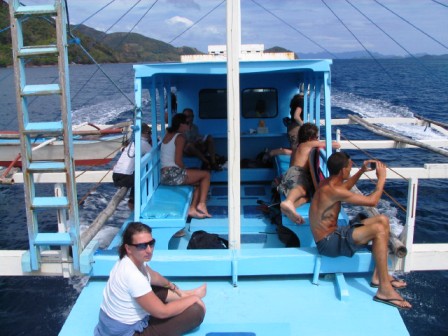|
18 January - 3 February 2008
Travelling around the Palawans is not easy, as we
discovered, but the pain was worth it. The resorts are small and laid
back and the corals just offshore gave us numerous opportunities for
snorkeling. Fifteen tourists, including us, piled on a large relatively
comfortable bangka boat for the seven hour trip from Coron to El Nido.
The town has a great backdrop of high, sheer karst cliffs and a long
beachfront but we arrived at 5:30 PM without a reservation. We had tried
to call from Coron but the phone connections were less than reliable.
All the beach front cabins were full or over priced. At least half the
boat passengers ended up with us at El Nido Plaza Inn, advertised as the
“cheapest in El Nido”. It had basic rooms with communal outside showers
and toilets but we took it anyway. It was clean, the bed was comfortable
and the price was right so we ended up staying for four days.
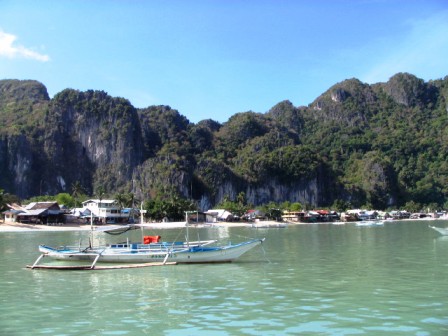 El Nido had great snorkel trips. We
shared two day trips with the same couple we had gone snorkeling with in
Coron. John, from
Ireland
and Brooke, from Toronto have been
working in Chamonix,
France
for the past three to five years. Tours are packaged in El Nido as
either “A”, “B” or “C”. Each includes four or five different locations.
We chose Tour “C” for our first as it promised the best snorkeling. It
worked out so well that we returned the next day for Tour “A”, another
excellent snorkeling trip. We saw purple lipped clams almost hidden in
the crevices of corals, lots of colourful corals, both hard and soft and
of course lots of fish. We spied on lots of Nemos and their cousins
jealously guard their anemone home. At the edge of a coral shelf on
Star
Beach we chased two sea
turtles as they swam along trying to avoid the interlopers into their
territory. We swam into an inner lagoon, looked into the depths and saw
two small black-tipped sharks below us. Apparently that lagoon has a
reputation for being a nursery for sharks, none of which are aggressive. El Nido had great snorkel trips. We
shared two day trips with the same couple we had gone snorkeling with in
Coron. John, from
Ireland
and Brooke, from Toronto have been
working in Chamonix,
France
for the past three to five years. Tours are packaged in El Nido as
either “A”, “B” or “C”. Each includes four or five different locations.
We chose Tour “C” for our first as it promised the best snorkeling. It
worked out so well that we returned the next day for Tour “A”, another
excellent snorkeling trip. We saw purple lipped clams almost hidden in
the crevices of corals, lots of colourful corals, both hard and soft and
of course lots of fish. We spied on lots of Nemos and their cousins
jealously guard their anemone home. At the edge of a coral shelf on
Star
Beach we chased two sea
turtles as they swam along trying to avoid the interlopers into their
territory. We swam into an inner lagoon, looked into the depths and saw
two small black-tipped sharks below us. Apparently that lagoon has a
reputation for being a nursery for sharks, none of which are aggressive.
We visited Matinloc Shrine, the
site of a pilgrimage on May 31 to honour the Virgin Mary. The site was
chosen after a vision of a heart-shaped island appeared to a believer. A
large Romblon marble rotunda held up by twelve columns was built around
a statue of the Virgin Mary. An impressive building was built into the
rocks next to the rotunda to house the pilgrims on their annual visit,
the only time it seems to be used.
Our most difficult trip so far, and
traveling in the
Philippines
is not easy, was the trip from El Nido to Port Barton. We had been told
of very uncomfortable trips coming north on a boat that battled high
waves the whole trip and everyone was soaked. We decided to take the
bus. The first five hours on the local bus, air cooled because it had no
windows, was fine. The roads were paved in spots, dirt on the rest.
Recent rains had turned one portion into an almost impassable mud
puddle.
 We were sold tickets that included
a jeepney ride from
San Jose,
the turnoff on the
National
Highway, to Port Barton, 22 km away. Four of
us, a German couple and Ray and I, got off at
San Jose to wait at a bus shelter for the
expected jeepney. Several tricycle and “single” (motorcycle) drivers
were resting in the shelter. They said the last jeepney left for Port
Barton at 11 AM and it was now 2 PM. They offered to take
us on the back of their single for P500 each. I thought they were
scamming us. After sitting around for one hour with no jeepney
appearing, we were left with no option but to accept their offer. We were sold tickets that included
a jeepney ride from
San Jose,
the turnoff on the
National
Highway, to Port Barton, 22 km away. Four of
us, a German couple and Ray and I, got off at
San Jose to wait at a bus shelter for the
expected jeepney. Several tricycle and “single” (motorcycle) drivers
were resting in the shelter. They said the last jeepney left for Port
Barton at 11 AM and it was now 2 PM. They offered to take
us on the back of their single for P500 each. I thought they were
scamming us. After sitting around for one hour with no jeepney
appearing, we were left with no option but to accept their offer.
Ray and the German couple took off
on new powerful motorcycles with their big backpacks held in front of
the driver. My driver had a smaller and older machine. I should have
chosen someone else for the trip. He stopped at the first “gas station”
to buy one litre of gas sold in a coke bottle (I paid the P50 – about
$1.25 CDN) which he emptied into his engine. He then tied my backpack on
the back of the seat and I got on in front of the bag. That would have
been alright except the seat was covered by a loose piece of plastic and
on every one of the downhills, however slight, I slid forward jamming
the driver into the handlebars. I was asked politely to please move back
so I spent the ride scooting back on the seat every 100 M. Add to that
the fact that one of the back footrests was broken so my left foot kept
slipping off and you can understand if I say it was not a comfortable
ride.
I soon found out why the cost for
the ride was so high. This was the worst road we have seen in the Philippines. None of the road is
paved and it sometimes drops off to nothing on one or both sides. It had
rained for the past few days, at times quite heavily and the road to
Port Barton, no great shakes at the best of times, was in horrible
condition. Before long we encountered the first of many mud holes. My
driver stopped and asked me to get off and walk on a narrow path
alongside the road. The driver waded into the mud to test out the depth
and then drove slowly through. He got to the other side of the puddle
the same time as I did. I lost count of how many mud puddles there were
on the 22 km of “road”. The driver with me seated behind did make it
through a few of the smaller mud puddles but the process of me getting
off and walking was repeated at least five more times.
It took the other three drivers one
hour to navigate the road. Ray’s driver lost one of his flip flops in
the mud and had to wade back to find it but Ray’s ride was easy compared
to mine. I got to Port Barton one half hour after everyone else with
both my backpack and me well mud splattered. I wouldn’t recommend the
trip. We found out later that there were no jeepneys that made the trip
that day, probably because of the condition of the road. Even two days
later other tourists that did manage the trip by jeepney told us they
had to get off the jeepney and walk twice and had been afraid of getting
stuck or overturning a few more times. The boat would have been a better
option.
Port Barton is a laid back fishing
town with a backdrop of green hills and good tourist facilities, once
you are there. Swimming is good off a long, sandy and clean beach.
There
is a good choice of places to stay at reasonable cost and the
restaurants are good. We stayed the first night in a lovely cottage set
in the gardens of Greenviews Resort. We would have stayed our whole
visit but our budget would have been considerably stretched. In stead we
transferred to a simpler room at Summer Homes Resort. Both are owned and
managed very well by British men.
Palawan
resort towns are filled with expatriots who have come and didn’t want to
leave so they have opened businesses to serve the growing tourist
industry. We stayed five days and started
to
get into the groove.
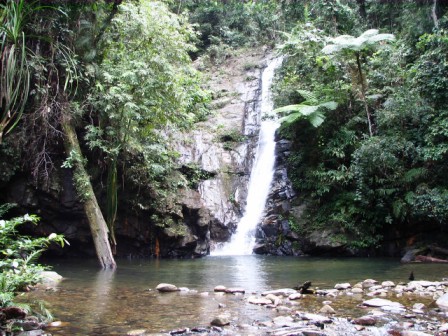 Our most ambitious event was a walk
to a waterfall about 4 km from the village. The path was advertised as
well marked it wasn’t. We explored several red herring trails before
asking directions from a local woman. Without her help I am sure we
would never have found our way. Our first challenge was fording a
section of the trail that was under water.
There were bamboo railing
erected for part of the way but not the entire distance. We had worn our
good walking shoes for the hike. After getting one foot wet I just waded
through the water that sometimes came up to my ankles but Ray stopped
and took off his shoes. Even he eventually gave up and put up with wet
shoes. The shoes got a bath and eventually dried out. The waterfalls
were quite lovely, a long stream off water that fell into a small pool.
We had a good swim to cool off after our walk. The only problem was on
the way out Ray discovered a leech on his ankle. I got a stick and with
some difficulty managed to dislodge it. I was glad I didn’t have any
leeches on me. Our most ambitious event was a walk
to a waterfall about 4 km from the village. The path was advertised as
well marked it wasn’t. We explored several red herring trails before
asking directions from a local woman. Without her help I am sure we
would never have found our way. Our first challenge was fording a
section of the trail that was under water.
There were bamboo railing
erected for part of the way but not the entire distance. We had worn our
good walking shoes for the hike. After getting one foot wet I just waded
through the water that sometimes came up to my ankles but Ray stopped
and took off his shoes. Even he eventually gave up and put up with wet
shoes. The shoes got a bath and eventually dried out. The waterfalls
were quite lovely, a long stream off water that fell into a small pool.
We had a good swim to cool off after our walk. The only problem was on
the way out Ray discovered a leech on his ankle. I got a stick and with
some difficulty managed to dislodge it. I was glad I didn’t have any
leeches on me.
We shared a Snorkel trip to the
corals another day with a Finnish couple. It was a very pleasant day
although the corals have been affected badly from illegal fishing using
dynamite and cyanide. The fish are easier to catch but the corals are
destroyed. The corals are coming back but it is a very slow process as
they only grow 1 cm per year.
There were fish to see but not as many as
some other places.
Out in the bay we passed by huge
expanses with black bouys marking the boundaries of pearl farms. Oyster
species that produces natural white, rose and black pearls have been
discovered to thrive in these waters. The government has given exclusive
use of these areas to the pearl farmers. The areas are heavily patrolled
and no fishing, diving or snorkeling is permitted within the boundaries.
That is too bad as the coral reefs within those areas would be in great
condition.
After swimming over a shallow coral
area aptly called the Aquarium, we stopped at a small resort, Blue
Cove, on Albiguin Island. If we had more time I would have
loved to stay there for a few days in one of their two spacious cabins.
There was a nice walk up a hill to enjoy the view, some nice corals to
explore from the beach and good food. We enjoyed a good fish dinner at a
table on the beach after our walk. Ah, that is the life!
A note has to be made about paying
for our lodging, food and trips. As we anticipated but most other people
did not, none of the resort towns in
Palawan
have banks or ATMs. Exchange rates, especially for the weak American
dollar are very low if obtainable at all and credit cards, which are
infrequently accepted charge a premium of 5 or 6%. We met several
tourists who had to cut short their visit or detour to Puerto Princesa
to get cash. Even buying airline tickets was a problem. There was one
agent in El Nido but Cebu Pacific, one of the most common carriers in
the area, does not accept either North American or European credit cards
on the Internet. Our friendly hotel owner in Port Barton, Dick, came to
our rescue. He phoned a friend in Puerto Princesa who bought tickets for
us and sent them via the next jeepney to Port Barton. This essential
service cost us and extra P500 but it was worth it.
We stayed long enough in Port Barton to participate in
another annual town Festival. The week long festivities were preceded by
a parade of all the school children on the beach in front of our hotel.
There were cock fights and of course an evening of dancing when Miss
Port Barton was chosen. As was the case in Long Beach, the winner is not
chosen on her looks alone. The winner is determined by the amount of
money she raises for the festival. Each of the eleven Poroks, which are
small subdivisions of Port Barton, choose a candidate.
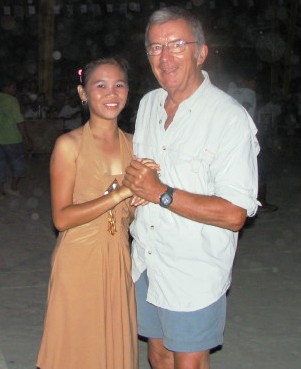 The local outdoor community center was decorated for
the windup event Sunday evening at which the winner of Miss Port Barton
would be selected. Residents dined at the many food booths set up around
the center for the event and took their places at tables inside. We
shared a table with other Summer Home guests and our snorkel tour driver
Dong. The eleven candidates, all high school students, were dressed in
their finest and seated on chairs at the edge of the dance floor.
The
Porok supporters had a last chance to help their candidate earn more
money by paying to dance with her. Dong told us the candidate from his
Porok would win. She had already raised quite a lot of money and she had
a loyal group of friends eager to dance with their favourite. One after
another they would put money in her collection tin and cut in to dance
with their candidate. Ray and several others at our table took their
turns as well. Periodically the music would stop and totals were
announced. Dong's candidate was always ahead and eventually was declared
Miss Port Barton. Finally the dance was turned over to the rest of the
crowd. It was lots of fun. The favourite dance was a circle of people
with individuals taking their turn to strut their stuff in the center.
We called it a night before midnight but the music went on until early
in the morning. The local outdoor community center was decorated for
the windup event Sunday evening at which the winner of Miss Port Barton
would be selected. Residents dined at the many food booths set up around
the center for the event and took their places at tables inside. We
shared a table with other Summer Home guests and our snorkel tour driver
Dong. The eleven candidates, all high school students, were dressed in
their finest and seated on chairs at the edge of the dance floor.
The
Porok supporters had a last chance to help their candidate earn more
money by paying to dance with her. Dong told us the candidate from his
Porok would win. She had already raised quite a lot of money and she had
a loyal group of friends eager to dance with their favourite. One after
another they would put money in her collection tin and cut in to dance
with their candidate. Ray and several others at our table took their
turns as well. Periodically the music would stop and totals were
announced. Dong's candidate was always ahead and eventually was declared
Miss Port Barton. Finally the dance was turned over to the rest of the
crowd. It was lots of fun. The favourite dance was a circle of people
with individuals taking their turn to strut their stuff in the center.
We called it a night before midnight but the music went on until early
in the morning.
Sabang is the site of the longest
Subterranean
River
in the
Philippines.
It used to be the longest in the world until a longer subterranean river
was discovered in
Laos. The easiest way to get to Sabang
from Port Barton is by boat. A tourist boat makes the trip from El Nido
to Sabang and back via Port Barton every day but a dispute with the
local boat association means the boats can drop off people in Port
Barton but they cannot pickup passengers. The alternative is to charter
a small bangka from the local Port Barton boat operators. We shared the
trip with an Italian couple who had been following the same trail as us
through the Palawans. Sailing from north to south was the way to go. The
winds are in your back so we had a calm 2 ½ hour ride.
Sabang is a very small fishing
village whose main income is tourists coming to vist the Subterranean
River.
It has a few small collections of tourist cabins lining a nice sandy
beach. Dab Dab, owned by Port Barton people, had been recommended to us.
It was a small collection of cottages set amongst nice gardens, not on
the best section of the beach but an easy walk to swimming. A bonus for
us was a large balcony from which to watch the world go by. Our first
day two local spear fishermen waded ashore carrying a load of large
squid while a large Osprey perched in a tree hoping for his chance at
catching fish.
Most tourists come on day trips
from Puerto Princessa, the largest town in the Palawans. The tours
consist of a 2 ½ hour bus ride to Sabang, a 20 minute boat trip to the
mouth of the Subterranean
River,
a 45 minute boat trip on the river and lunch before the return trip to
Puerto Princesa. We opted to walk to the mouth of the river. There were
two good trails to follow, each about five km long from Dab Dab Resort
to the River. We took the Jungle Trail to get there and the Monkey
Trail, which followed the coastline, to return. Both trails involve
steep climbs up a few hills and across rocky points. A sign on the trail
said that 365 wooden steps and 367 concrete steps on the Monkey Trail
were constructed by 100 men in 14 days. The steps were constructed from
the top down using fallen forest trees so that the wood could be carried
down the mountain rather than carried up.
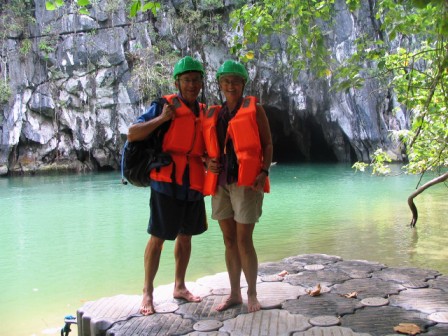 The
Subterranean
River
cruise was very interesting. Small bangkas filled with six to eight
tourists clad in orange life vests and green hard hats were paddled 1 ½
km into the river by a guide who kept up a running commentary.
The river
is 8 km long but only the first 5 km are accessible and that distance
only by special permission. It was low tide so we didn’t have to worry
about hitting our heads on the stalactites hanging from the ceiling. The
sections we traveled through were huge with the highest point over 60 m.
Several of the largest stalactites and stalagmites have all been named
according to their suggested shapes. In a Catholic country like the
Philippines
it was not surprising that several had biblical connotations. Caves have
bats and there are four varieties in the
Subterranean
River. We saw large
colonies clustered on the ceiling of the caves, only fluttering away
when the spotlight, directed by Ray, woke them from their sleep. The
Subterranean
River
cruise was very interesting. Small bangkas filled with six to eight
tourists clad in orange life vests and green hard hats were paddled 1 ½
km into the river by a guide who kept up a running commentary.
The river
is 8 km long but only the first 5 km are accessible and that distance
only by special permission. It was low tide so we didn’t have to worry
about hitting our heads on the stalactites hanging from the ceiling. The
sections we traveled through were huge with the highest point over 60 m.
Several of the largest stalactites and stalagmites have all been named
according to their suggested shapes. In a Catholic country like the
Philippines
it was not surprising that several had biblical connotations. Caves have
bats and there are four varieties in the
Subterranean
River. We saw large
colonies clustered on the ceiling of the caves, only fluttering away
when the spotlight, directed by Ray, woke them from their sleep.
Jeepney trips are the slow but
inexpensive way to travel. The trip from Sabang to Puerto Princessa,
about 65 km away, was typical. The jeepney, advertised as leaving at 9
AM left at 10 AM. We stopped multiple times, sometimes just 100 M from
the previous stop, to pick up passengers and more frequently, goods
being shipped to market. Our luggage kept company on the top of the
jeepney with one baby pig, bags of copra, which is the dried inner meat
of coconuts, split bamboo poles, and nipa palm leaf thatching. A rooster
sat quietly on its owner’s lap and more bags of copra covered the floor.
Large boxes of freshly caught squid and fish were strapped on either
side of the back door and excess passengers either sat on top or hung
onto the back. The driver also stopped a few times to pick up and
deliver mail. Such is the life of a jeepney rider.
We just stayed in Puerto Princesa
long enough to visit the excellent restaurant KaLui for dinner and catch
a flight to Cebu, the second largest city in the Philippines, the next
morning. We didn’t linger in
Cebu
either. It was not an enticing town, just crowded with people and
traffic. Cebu was simply the departure point for a boat to Tagbilaran,
Bohol
Island, another
unattractive town with tricycle traffic jams.
Bohol
is the site of the much hyped Chocolate Hills and tiny Tarsier monkeys.
We arranged a car and driver for a sightseeing tour. Both areas were
more touristy and less rugged than we had expected but we had an
enjoyable day. 1268 small rounded hills are clustered in the highlands
about 40 km from Tagbilaran. They were formed when coral reefs were
pushed up from the ocean floor and then were worn down and eaten away by
acidic rains. In the summer time, the vegetation turns brown, hence the
name Chocolate Hills. At the time of our visit most of the hills were
still green, but it was impressive to see so many of these round bumps
littering the landscape. Concrete steps made it easy to walk up to the
top of one of the hills to get the view. If you want, one of the
resident photographers will even take your picture jumping over one of
the hills in the background.
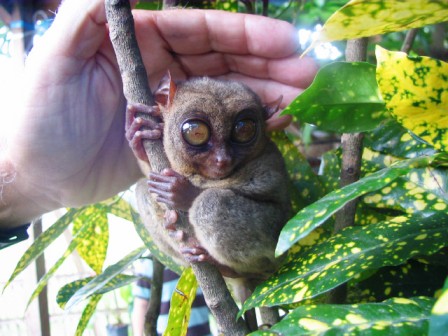 The Tarsier monkeys are the
smallest primates in the world. These small furry animals, looking more
like a gremlin with huge eyes, would easily fit into the palm of your
hand. The center we visited had rows of small trees each with its
resident monkey clinging to the tree and trying to get some sleep so
that they would be awake for their grasshopper treats at night. There
was also a resident lemur, hanging upside down on a branch trying to get
some shut eye. Its limbs are joined by large flaps of skin which aid in
its flights from tree to tree. None of the animals in this center were
caged but they all seemed to tolerate all the attention and didn’t try
to run away. The Tarsier monkeys are the
smallest primates in the world. These small furry animals, looking more
like a gremlin with huge eyes, would easily fit into the palm of your
hand. The center we visited had rows of small trees each with its
resident monkey clinging to the tree and trying to get some sleep so
that they would be awake for their grasshopper treats at night. There
was also a resident lemur, hanging upside down on a branch trying to get
some shut eye. Its limbs are joined by large flaps of skin which aid in
its flights from tree to tree. None of the animals in this center were
caged but they all seemed to tolerate all the attention and didn’t try
to run away.
We
stopped to admire two
of the oldest Spanish
churches
on Bohol. Baclayon Church was started in 1595 while San Pedro, with an
interesting bell tower, was started in 1608.
Our trip was rounded out by a visit to
a memorial to
a goodwill
blood signing
between
the Bohol
chief Sikatuna and the Spanish Conquistador
Legazpi. Little did
they know how that encounter would send the Filipinos into three hundred
years of colonialism.
We rounded out our day by a meal in
a streetside Barbeque in Tagbilaran. The corner of the street where our
hotel was located came alive each night. Multiple vendors lit their
charcoal burners and cooked up skewers of chicken, pork, livers and
other meats I couldn’t identify. Customers eat their meat selections at
the tables set up under tarpaulins accompanied by palm leaf wrapped
portions of rice. It was very good and very inexpensive.
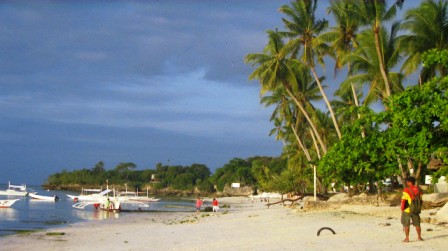 After
our Chocolate Hills tour we returned to the beach. The
small island of
Panglao is joined to Tagbilaran by two
causeways. An easy tricycle ride took us to the resort town of
Alona
Beach on one side of Panglao. Cabins and resorts line the white sand beach and
stretch back several blocks. It was the beginning of the Chinese New Year
holiday and Asians flocked to the
Philippines
for their vacation. We were lucky to find a room even at a somewhat
inflated price. Tourists are drawn to Alona for the diving for there are
many dive sites just offshore. One of the dive masters
told us we
could snorkle right off the beach. We tried it and couldn’t get over how good it
was. The community had designated part of the coast as
a protected marine
area and it was there, right next to the white sand beach that we saw
some of the best corals to date. We were able to swim 50 M offshore to
find that the reef dropped off sharply. This is where the most
and biggest fish
congregate. We even followed divers who were exploring the reef below
where we were swimming. We didn't have to bother with an expensive
boat trip. We got all the snorkeling we wanted right
off the beach. After
our Chocolate Hills tour we returned to the beach. The
small island of
Panglao is joined to Tagbilaran by two
causeways. An easy tricycle ride took us to the resort town of
Alona
Beach on one side of Panglao. Cabins and resorts line the white sand beach and
stretch back several blocks. It was the beginning of the Chinese New Year
holiday and Asians flocked to the
Philippines
for their vacation. We were lucky to find a room even at a somewhat
inflated price. Tourists are drawn to Alona for the diving for there are
many dive sites just offshore. One of the dive masters
told us we
could snorkle right off the beach. We tried it and couldn’t get over how good it
was. The community had designated part of the coast as
a protected marine
area and it was there, right next to the white sand beach that we saw
some of the best corals to date. We were able to swim 50 M offshore to
find that the reef dropped off sharply. This is where the most
and biggest fish
congregate. We even followed divers who were exploring the reef below
where we were swimming. We didn't have to bother with an expensive
boat trip. We got all the snorkeling we wanted right
off the beach.
| 